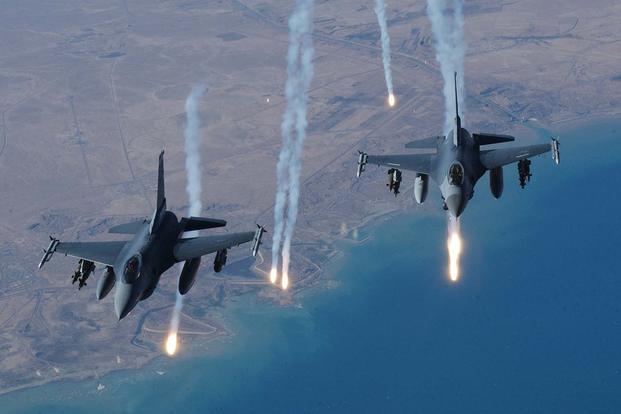The service dropped nearly 4,000 munitions during that period, according to the latest Air Forces Central Command statistics.
The Air Force unleashed more than 3,000 bombs in November 2015 and again the following month -- an increased level of activity following the Paris terrorist attacks that killed over 100 people.
The U.S. air campaign remained fairly steady in the succeeding months, hovering at around 2,500 weapons released. Then again in June, the Air Force found itself in another busy month, with 3,160 weapons dropped over Iraq and Syria. Operations last summer, in which fighter jets and strategic bombers were focused on Fallujah and Mosul in Iraq, and Raqqa in Syria, hit an all-time high for the service.
RELATED: Air Force 'Flexible' on B-1’s Return to Fight Against ISIS
The service has deployed a wide variety of aircraft to the missions in both countries, including fighters and bombers such as the F-15E Strike Eagle, F-16 Fighting Falcon, B-52 Stratofortress, F-22 Raptor, and intelligence, surveillance and reconnaissance aircraft armed with Hellfire missiles, such as the MQ-1 Predator and MQ-9 Reaper.
The coalition launching airstrikes -- the United Kingdom, Australia, Iraq, the Netherlands, Canada, France, Jordan, among others -- has focused on backing Iraqi ground forces as they fight to liberate western Mosul from ISIS. The push, which began in October, has expelled the majority of ISIS fighters. The militants now only control a small stronghold in the city limits, Reuters reported Tuesday.
During the Mosul liberation, the Pentagon in March launched an investigation into a collateral strike. Mosul residents at the time said an airstrike killed more than 100 civilians sheltering in a house in the western part of the Iraqi city that was also being used by IS fighters.
Air Force Col. John Dorrian, the spokesman for Combined Joint Task Force-Operation Inherent Resolve, told The Associated Press following the incident that the coalition's anti-ISIS operations remain "the most precise air campaign in history."
RELATED: 'Intense' US Bombing in Mosul Meant Strike Every 8 Minutes
"But all the tactics, techniques and procedures and plans that we have, all these things are executed by people," Dorrian said, "and what that means is, it's not going to be perfect, it's going to be as good as we can possibly make it."
Although watchdog groups such as Airwars have maintain the coalition has claimed more than 3,530 civilian lives, the Pentagon acknowledged in April that at least 352 civilians have been killed by coalition strikes since the start of the air campaign.
Between Aug. 8, 2014, and May 8, 2017, U.S. and partner-nation aircraft have flown 152,208 sorties in support of operations in Iraq and Syria, according to the Defense Department.
The U.S. so far has spent more than $12.5 billion on the campaign.
Meanwhile, in Afghanistan, where the U.S. continues to fight insurgents such as the Taliban, al-Qaeda and ISIS, the Air Force dropped more than 200 munitions in March -- relatively high thus far for the year, AFCENT says.
-- Oriana Pawlyk can be reached at oriana.pawlyk@military.com. Follow her on Twitter at @Oriana0214.





























